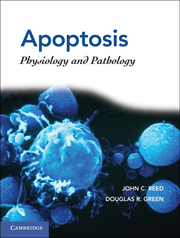Book contents
- Frontmatter
- Contents
- Contributors
- Part I General Principles of Cell Death
- Part II Cell Death in Tissues and Organs
- 11 Cell Death in Nervous System Development and Neurological Disease
- 12 Role of Programmed Cell Death in Neurodegenerative Disease
- 13 Implications of Nitrosative Stress-Induced Protein Misfolding in Neurodegeneration
- 14 Mitochondrial Mechanisms of Neural Cell Death in Cerebral Ischemia
- 15 Cell Death in Spinal Cord Injury – An Evolving Taxonomy with Therapeutic Promise
- 16 Apoptosis and Homeostasis in the Eye
- 17 Cell Death in the Inner Ear
- 18 Cell Death in the Olfactory System
- 19 Contribution of Apoptosis to Physiologic Remodeling of the Endocrine Pancreas and Pathophysiology of Diabetes
- 20 Apoptosis in the Physiology and Diseases of the Respiratory Tract
- 21 Regulation of Cell Death in the Gastrointestinal Tract
- 22 Apoptosis in the Kidney
- 23 Physiologic and Pathological Cell Death in the Mammary Gland
- 24 Therapeutic Targeting Apoptosis in Female Reproductive Biology
- 25 Apoptotic Signaling in Male Germ Cells
- 26 Cell Death in the Cardiovascular System
- 27 Cell Death Regulation in Muscle
- 28 Cell Death in the Skin
- 29 Apoptosis and Cell Survival in the Immune System
- 30 Cell Death Regulation in the Hematopoietic System
- 31 Apoptotic Cell Death in Sepsis
- 32 Host–Pathogen Interactions
- Part III Cell Death in Nonmammalian Organisms
- Plate section
- References
15 - Cell Death in Spinal Cord Injury – An Evolving Taxonomy with Therapeutic Promise
from Part II - Cell Death in Tissues and Organs
Published online by Cambridge University Press: 07 September 2011
- Frontmatter
- Contents
- Contributors
- Part I General Principles of Cell Death
- Part II Cell Death in Tissues and Organs
- 11 Cell Death in Nervous System Development and Neurological Disease
- 12 Role of Programmed Cell Death in Neurodegenerative Disease
- 13 Implications of Nitrosative Stress-Induced Protein Misfolding in Neurodegeneration
- 14 Mitochondrial Mechanisms of Neural Cell Death in Cerebral Ischemia
- 15 Cell Death in Spinal Cord Injury – An Evolving Taxonomy with Therapeutic Promise
- 16 Apoptosis and Homeostasis in the Eye
- 17 Cell Death in the Inner Ear
- 18 Cell Death in the Olfactory System
- 19 Contribution of Apoptosis to Physiologic Remodeling of the Endocrine Pancreas and Pathophysiology of Diabetes
- 20 Apoptosis in the Physiology and Diseases of the Respiratory Tract
- 21 Regulation of Cell Death in the Gastrointestinal Tract
- 22 Apoptosis in the Kidney
- 23 Physiologic and Pathological Cell Death in the Mammary Gland
- 24 Therapeutic Targeting Apoptosis in Female Reproductive Biology
- 25 Apoptotic Signaling in Male Germ Cells
- 26 Cell Death in the Cardiovascular System
- 27 Cell Death Regulation in Muscle
- 28 Cell Death in the Skin
- 29 Apoptosis and Cell Survival in the Immune System
- 30 Cell Death Regulation in the Hematopoietic System
- 31 Apoptotic Cell Death in Sepsis
- 32 Host–Pathogen Interactions
- Part III Cell Death in Nonmammalian Organisms
- Plate section
- References
Summary
Introduction
The Edwin Smith Papyrus, the only surviving copy of the ancient Egyptian textbook on trauma surgery, shows that the therapeutic challenge of protecting the nervous system after spinal cord injury (SCI) has burdened man for millenia (Haas, 1999). During the past 5,000 years, the sense of urgency surrounding treatment for this important malady has only grown as preventive measures have failed to eradicate it (Gupta et al., 2009; Gupta et al., 2008). Given the daunting challenges in repairing the injured spinal cord according to the accurate anatomic descriptions of the ancient Papyrus, it is not surprising that attention has focused on preventing cell death after injury (Faden & Stoica 2007). This chapter traces some of the intellectual antecedents underlying our current models of death and survival in the spinal cord after trauma and culminates in a discussion of the potential therapeutic implications of the field's journey to date, focusing on the concept of apoptosis and its now appreciated variants.
- Type
- Chapter
- Information
- ApoptosisPhysiology and Pathology, pp. 164 - 175Publisher: Cambridge University PressPrint publication year: 2011

